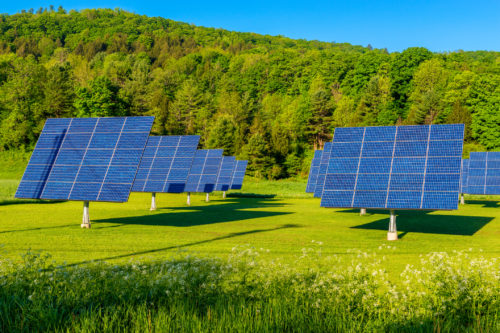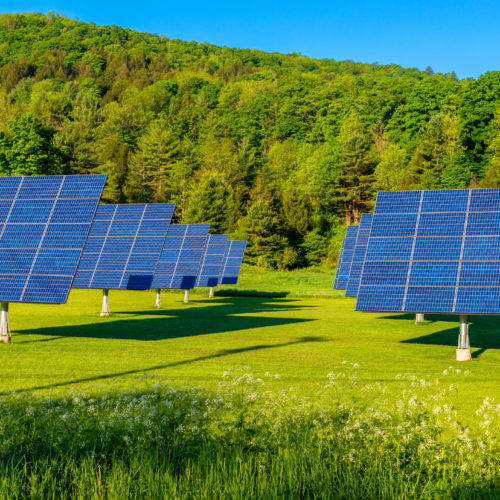Solar Panels in a Field in Woodstock, Vermont, USA on early spring day.

How to Plan for a More-Distributed Grid, Part 2
Four Exciting Projects from around the Country, Part Two of Three
This is the second blog in a three-part series. The first blog is available here.
One of the main themes at the 2018 Rocky Mountain Institute Electricity Innovation Lab (e–Lab) Accelerator event, held in Sundance, Utah, in May, was distributed grid infrastructure—the use of least-cost portfolios of distributed energy resources (DERs) to complement traditional electric grid infrastructure or to defer or avoid investments in it. These combinations, also known as clean energy portfolios (CEPs), consist of resources like utility-scale and distributed wind and solar generation, battery energy storage, energy efficiency, and demand-response technologies used in place of new power plants or transmission and distribution infrastructure.
In a recent report, The Economics of Clean Energy Portfolios, RMI showed that new-built CEPs are already an economically attractive alternative to new gas-fired power plants in most cases and are likely to beat just the operating costs of efficient gas-fired power plants within the next two decades. Four teams came to Accelerator 2018 to work on distributed grid infrastructure projects. These are their stories.
Planning for High Renewables Penetration
A team from New Mexico came to Accelerator to focus on a common problem: how to integrate large quantities of renewable energy onto the electric grid. It is possible to achieve a system that gets the majority of its energy from renewables, and such systems can be more reliable than grids that rely predominantly on fossil fuels. But the transition can be tricky. Representatives of New Mexico’s state and local governments, nonprofits, and the investor-owned utility Public Service Company of New Mexico (PNM) wrestled at Accelerator with how to plan for and achieve that transition.
PNM has already announced an integrated resource plan that goes beyond New Mexico’s renewable portfolio standard of 20 percent by 2020 (PNM already exceeds the current standard of 15 percent) by adding wind, solar, and geothermal supply, together with energy efficiency and demand response. The utility also plans to retire its coal generation fleet entirely by 2031. PNM is considering an eventual transition to 100 percent renewable generation, as are stakeholder groups across the state. But increasing the percentage of renewables generation above a threshold of about 30 percent raises difficult operational issues.
The team’s facilitator, Kendall Ernst, a senior associate at RMI, said that “all the different parties, really the team as a whole, had a very similar vision of what the future could be.” When they discussed their vision of what PNM’s grid would look like in 2050, they agreed that it could be clean, renewable, supplied by diverse resources, and low cost. But how to get there? And how quickly is it feasible to achieve intermediate goals, like 50 percent penetration? They found that these steps are difficult to plan.
To begin with, there are regulatory issues that complicate adding additional renewables: regulations mandate choosing the least-cost option. Using natural gas-fired power can be less expensive than adding more solar capacity. And there are rules about avoiding duplicative resources that complicate adding solar capacity that only yields power during part of the day; it can be construed as being duplicative with existing resources that can operate around the clock. Storage would be an effective solution to that obstacle, but it is difficult to say how inexpensive storage will be in 2030, 2040, or 2050. The economic value of adding gas-fired power plants depends, among other variables, on the future cost of storage. In the long term, the falling price of renewables and storage increasingly will challenge the economics of gas-fired generation, as RMI’s Economics of Clean Energy Portfolios report showed. But the medium term is where the tough questions lie.
Those medium-term questions include: What mix of resources is right for each year? What will be the cost of storage and other distributed energy resources? Will investors and developers that today fund development of fossil fuel assets that are being built for tomorrow receive acceptable returns as the grid evolves? And what makes the most sense to use as a bridge resource between the present and the clean, renewable future? The team made progress on finding how to answer these questions for New Mexico, considering the proper role of governments and advocates in setting such intermediate goals, and they discussed how scenario planning can best be accomplished. It is efforts like theirs that may help solve how to handle the clean-energy transition.
Optimizing Buildings to Interact with the Grid
Another team grappling with integrating renewables into the grid was the GridOptimal Initiative, which focused on how buildings can be made smarter and more responsive to the grid by using distributed renewables and automated management like smart controls and demand response. GridOptimal is a joint effort by the New Buildings Institute and the US Green Building Council to create a rating system that provides standardized metrics, tools, and guidance to improve building-grid interactions, and to help both building owners and utilities shape the value and opportunity of grid-integrated buildings. Representatives from utilities including Sacramento Municipal Utility District and Austin Energy were there, as well as other stakeholders. Grid-integrated buildings, supported by initiatives like GridOptimal, present an exciting opportunity to go beyond net-zero energy structures and provide valuable benefits to the electric grid while also earning money for building owners. A full discussion of this team’s exciting topic is available here.
The work of the other two teams is discussed in other blogs. The first blog in this series is available here.

